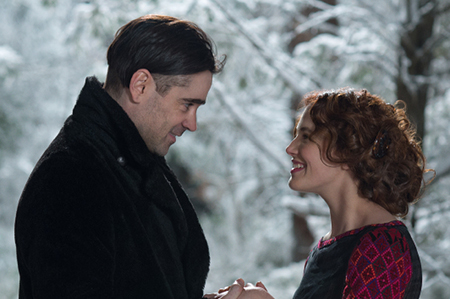One of the first things I did after seeing the trailer for Akiva Goldsman’s adaptation of Winter’s Tale was to look it up on IMDB to see if that was really William Hurt playing Beverly’s father (it was) and then to see what else I could learn about the cast who weren’t featured in that preview. I could see Jennifer Connelly would be playing Virginia Gamely, but who’d be playing her husband, Hardesty Marratta? Who’d be playing their mutual employer, Isaac Penn, and his dim-witted arch nemesis, Craig Binky? Who’d be playing the otherworldly engineer, Jackson Mead?
It turns out none of them are listed in the cast of characters, and that makes it seem likely that the trailer isn’t just cherrypicking elements of the love story between Peter Lake and Beverly Penn for the sake of a streamlined trailer—my guess is that the film itself has jettisoned huge chunks of Mark Helprin’s 750-page novel in favor of just one of its storylines. Granted, in many ways it’s the most obvious storyline to pluck from the book, lending itself most readily to an economically viable cinematic venture. And yet I fear that, in an effort to capture “the heart of the book,” Goldsman may miss the mark rather widely.
Nobody could expect all of Winter’s Tale to survive the transition to film, of course, and though it would be sad to lose, say, Hardesty’s cross-country trek from San Francisco to New York—especially that disaster-prone interlude with vagabond Jesse—one could accept it in the name of exigency. But to lose the entirety of the war between New York’s two great newspapers, The Sun and The Ghost? Or the arrival of Jackson Mead in his humongous ship, and his audacious mission, and the apocalyptic conflagration that engulfs Manhattan?
Which, okay, was probably one of those things that (so it’s said) made Martin Scorsese deem the book “unfilmable” on the budgetary level alone, not to mention that it might hit a little too close to home in the post-9/11 era.
But if you toss out the newspapers, that means you probably also lose the scene where an amnesiac Peter Lake dazzles the mechanics at the Sun printing presses with his knowledge of their arcane machinery, one of the most charming sequences in the novel. Not to mention the “early summer dinner at Petipas,” where he appears to several of the modern-day characters—including Virginia, Hardesty, and Isaac Penn—almost as an apparition, the significance of which they don’t quite grasp.
The greatest potential loss that comes from focusing on the fairy tale romance of Peter Lake and Beverly Penn, though, is the bigger fairy tale of New York City, with its “great plumes of steam a hundred stories tall, river traffic that ran a race to silver bays, and countless thousands of intersecting streets that sometimes would break away from the grid and soar over the rivers on the flight path of a high bridge.” As Prager de Pinto, another character who is apparently nowhere to be found in the film, declares during his surreal campaign against the incumbent Ermine Mayor, “It’s a hard place—too big for most, and nearly always incomprehensible.” Even then, though, “it seems like a single work of art shrouded in changing galleries of climate, a sculpture of unfathomable detail standing on the floor of an orrery that is filled with bright lights and golden suns.”
It’s an aspect of Winter’s Tale I didn’t really get when I read it as a teenager in the mid-1980s, one I only came to understand after I’d lived in the outer boroughs of the city for several years myself, and which I felt keenly in my most recent reread. I won’t go so far as to say that New York City has become a magical kingdom for me, too, but I’m better able to see now why it takes on that role for others, why its physical landscape has assumed such fantastic dimensions. A close parallel that springs to mind is Wes Anderson’s The Royal Tenenbaums; all of Anderson’s films, I think, take place in a kind of fairy tale dreamscape, but in this case it’s specifically a Manhattan dreamscape, visually recognizable yet experientially off-kilter. Helprin’s Manhattan is much the same, not just in the present day but throughout its entire existence—and perhaps it’s only in a Manhattan like that of Winter’s Tale that the story of Peter Lake and Beverly Penn could take root.
If that magical city somehow finds its way into the Winter’s Tale movie, I’ll be delightfully surprised. What I’ve seen so far, though, is not Helprin’s magical world where magical things happen as a matter of course, but a sudden burst of magic into our otherwise ordinary world… which is also capable of moving us, I suppose, under the right circumstances, but so far afield from the novel that touched my heart that I’m almost disappointed to see it out in the world bearing that book’s trappings.
Ron Hogan is the host of The Handsell with Ron Hogan &…, a video series where authors and independent booksellers offer reading recommendations based on the books you already love.










